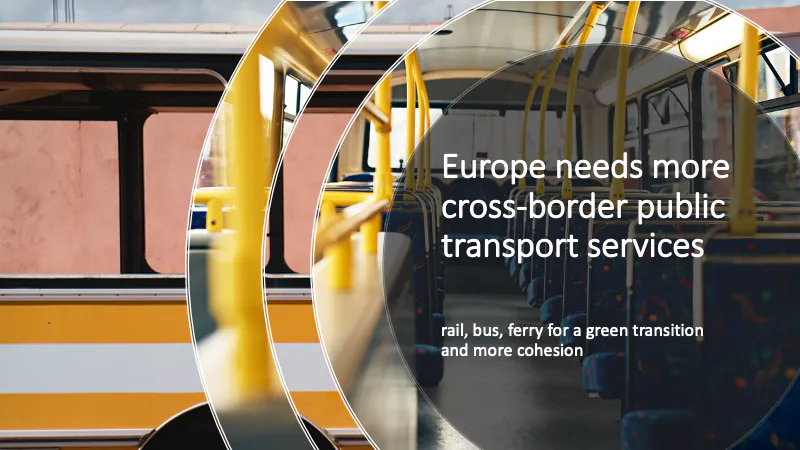Green transition needs cross-border public transport
February 2022

The green and just transition of Europe needs a greater shift to soft mobility and public transport. This is not equally easy in all places. When public transport services need to operate across national borders, there is another layer of complexity.
Given that about 1/3 of the population in the EU lives in regions bordering other EU member states, cross-border public transport is an important element of our transition to a green and just future.
Generally, cross-border public transport is defined as a regular, scheduled transport service in a border region, which is available to the general public and has at least one stop on each side of the border in the cross-border region. Services that cross a border but do not stop on both sides within the cross-border region, or services that start in the border areas but do not cross the national border are not cross-border public transport services.
Cross-border public transport services in Europe
A recent study (Opens in a new window) provides a good overview on the state of play of cross-border public transport services in the EU and neighbouring countries. In rough terms, following services are available:
1,414 cross-border rail services were operated in winter 2019/20, some of which even cross more than one national border while still serving the border regions. The borders between Austria and Germany, Germany and Switzerland, Italy and Switzerland, as well as France and Switzerland stand out as the areas with the highest numbers of cross-border rail services offered. On the other end of the spectrum, there are border areas in Estonia, Latvia, Lithuania, Ireland, Bulgaria and Greece, where one finds the lowest numbers of cross-border rail services.
5,312 cross-border bus services are available. 62% of which are operated in urban border-regions, and 37% are long-distance express services extending beyond the immediate border regions. Services mainly for tourists or school busses account for less than 1% of all cross-border bus services. Along the borders between Germany and Netherlands, Germany and Austria, Germany and France, Netherlands and Belgium, France and Switzerland, one finds the highest numbers of cross-border bus services.
200 cross-border ferry services offer water-born cross-border public transport and have been only considered if the one-way crossing is below one hour. Most of them are passenger ferries and only a few are car ferries. Cross-border passenger ferry services are mainly to be found on Lake Constance (Austria, Germany Switzerland), Lake Geneva (France, Switzerland), Lake Maggiore (Italy, Switzerland). Cross-border car ferry services are mainly to be found on the Danube between Bulgaria and Romania, over the Fehmarn Belt between Denmark and Germany, in the Øresund between Denmark and Sweden. There are also cross-border car ferry services connecting islands. This is e.g. the case for ferries connecting English channel islands to France, Sardinia to Italy, or the Germany island Sylt to the Danish island Rømø.
23 cross-border tram services exist so far. All of them are in agglomeration areas and twin-cities at the borders between France, Germany and Switzerland.
To read this post you'll need to become a member. Members help us fund our work to ensure we can stick around long-term.
See our plans (Opens in a new window)
Already a member? Log in (Opens in a new window)


